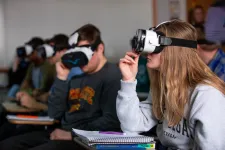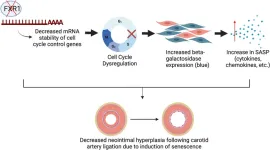(Press-News.org) Artificial intelligence (AI) technology in the medical field has the possibility to automate diagnoses, decrease physician workload, and even to bring specialized healthcare to people in rural areas or developing countries. However, with possibility comes potential pitfalls.
Analyzing crowd-sourced sets of data used to create AI algorithms from medical images, University of Maryland School of Medicine (UMSOM) researchers found that most did not include patient demographics. In the study published April 3 in Nature Medicine, the researchers also found that the algorithms did not evaluate for inherent biases either. That means they have no way of knowing whether these images contain representative samples of the population such as Blacks, Asians, and Indigenous Americans.
According to the researchers, much of medicine in the U.S. is already fraught with partiality toward certain races, genders, ages, or sexual orientations. Small biases in individual sets of data could be amplified greatly when hundreds or thousands of these datasets are combined in these algorithms.
“These deep learning models can diagnose things physicians can’t see, such as when a person might die or detect Alzheimer’s disease seven years earlier than our known tests — superhuman tasks,” said senior investigator Paul Yi, MD, Assistant Professor of Diagnostic Radiology and Nuclear Medicine at UMSOM. He is also Director of University of Maryland Medical Intelligent Imaging (UM2ii) Center. “Because these AI machine learning techniques are so good at finding needles in a haystack, they can also define sex, gender, and age, which means these models can then use those features to make biased decisions.”
Much of the data collected in large studies tends to be from people of means who have relatively easy access to healthcare. In the U.S., this means the data tends to be skewed toward men versus women, and toward people who are white rather than other races. As the U.S. tends to perform more imaging than the rest of the world, this data gets compiled into algorithms that have the potential to slant outcomes worldwide.
For the current study, the researchers chose to evaluate the datasets used in data science competitions in which computer scientists and physicians crowdsource data from around the world and try to develop the best, most accurate algorithm. These competitions tend to have leaderboards that rank each algorithm and provide a cash prize, motivating people to create the best one. Specifically, the researchers investigated medical imaging algorithms, such as those that evaluate CT scans to diagnose brain tumors or blood clots in the lungs. Of the 23 data competitions analyzed, 61 percent did not include demographic data such as age, sex, or race. None of the competitions had evaluations for biases against underrepresented or disadvantaged groups.
“We hope that by bringing awareness to this issue in these data competitions – and if applied in an appropriate way – that there is tremendous potential to solve these biases,” said lead author Sean Garin, Program Coordinator at the UM2ii Center.
The study’s authors also encourage future competitions to require not only high accuracy, but also fairness among different groups of people.
“As AI models become more prevalent in medical imaging and other fields of medicine, it is important to identify and address potential biases that may exacerbate existing health inequities in clinical care – an essential priority for every academic medical institution,” said UMSOM Dean Mark T. Gladwin, MD, Vice President for Medical Affairs, University of Maryland, Baltimore, and the John Z. and Akiko K. Bowers Distinguished Professor.
About the University of Maryland School of Medicine
Now in its third century, the University of Maryland School of Medicine was chartered in 1807 as the first public medical school in the United States. It continues today as one of the fastest growing, top-tier biomedical research enterprises in the world — with 46 academic departments, centers, institutes, and programs, and a faculty of more than 3,000 physicians, scientists, and allied health professionals, including members of the National Academy of Medicine and the National Academy of Sciences, and a distinguished two-time winner of the Albert E. Lasker Award in Medical Research. With an operating budget of more than $1.3 billion, the School of Medicine works closely in partnership with the University of Maryland Medical Center and Medical System to provide research-intensive, academic, and clinically based care for nearly 2 million patients each year. The School of Medicine has nearly $600 million in extramural funding, with most of its academic departments highly ranked among all medical schools in the nation in research funding. As one of the seven professional schools that make up the University of Maryland, Baltimore campus, the School of Medicine has a total population of nearly 9,000 faculty and staff, including 2,500 students, trainees, residents, and fellows. The combined School of Medicine and Medical System (“University of Maryland Medicine”) has an annual budget of over $6 billion and an economic impact of nearly $20 billion on the state and local community. The School of Medicine, which ranks as the 8th highest among public medical schools in research productivity (according to the Association of American Medical Colleges profile) is an innovator in translational medicine, with 606 active patents and 52 start-up companies. In the latest U.S. News & World Report ranking of the Best Medical Schools, published in 2021, the UM School of Medicine is ranked #9 among the 92 public medical schools in the U.S., and in the top 15 percent (#27) of all 192 public and private U.S. medical schools. The School of Medicine works locally, nationally, and globally, with research and treatment facilities in 36 countries around the world. Visit medschool.umaryland.edu
END
AI in medical imaging could magnify health inequities, study finds
Addressing biases now and promoting awareness can encourage fairness in medicine
2023-05-02
ELSE PRESS RELEASES FROM THIS DATE:
Cybersickness more likely to affect women, ongoing research to understand why
2023-05-02
AMES, IA — Iowa State researchers in psychology and engineering found women experience cybersickness with virtual reality headsets more often than men. Their ongoing work, supported by a new $600,000 grant from the National Science Foundation, explores why this difference exists and options to help individuals adapt.
Psychology professor Jonathan Kelly studies human computer interaction, spatial cognition and virtual reality. He says gender discrepancies in cybersickness may not seem that important when it’s related to video games and other forms of entertainment.
"But it’s still a problem, and when VR gets to the point ...
A method to access genetic information in blood samples and find correlations with mental health problems
2023-05-02
Using blood samples to study diseases that originate in the brain is a difficulty faced by psychiatric genetics in the search for markers of mental health disorders. Researchers at the Federal University of São Paulo (UNIFESP) in Brazil have shown that this hindrance can be surmounted by analyzing microRNAs in extracellular vesicles (EVs), which are produced by most cells in the body, including neurons and other nervous system cells.
The study was supported by FAPESP and is reported ...
Air pollution may increase risk of dementia, complicated by genetics
2023-05-02
Three years ago, an international study commissioned by the journal Lancet listed 12 modifiable factors that increased the risk of dementia, including three new ones: excessive alcohol, head injury and air pollution.
Writing in the May 2, 2023 issue of the Journal of Alzheimer’s Disease, a team of researchers, led by scientists at University of California San Diego, further elaborate on how exposure to the last of those new factors — ambient air pollution, such as car exhaust and power plant emissions — is associated with a measurably greater risk of developing dementia over time.
Senior author William S. Kremen, PhD, professor ...
New RNA-seq, metabolomics protocol offers more efficient extraction that maintains data integrity
2023-05-02
GRAND RAPIDS, Mich. (May 2, 2023) — Van Andel Institute scientists have developed a new extraction protocol for RNA-seq and metabolomic analysis, offering a more complete picture of cellular activity than either technique on its own.
The protocol employs a streamlined extraction from a single sample, which reduces variation, improves efficiency, preserves data fidelity and maximizes use of precious biospecimens.
“Our new technique enables researchers to study metabolic phenotypes in a unique way while getting the most information we can out of single samples,” ...
UMass Chan scientists deliver siRNA therapy to lung
2023-05-02
Scientists at UMass Chan Medical School have developed a technology to deliver gene therapy directly to lung tissue through intranasal administration, a development that could potentially create a new class of treatments for lung disease.
Published in The Proceedings of the National Academy of Sciences, the study by a multidisciplinary team of RNA biologists, chemical biologists, immunologists and virologists describes the delivery of siRNA molecules locally to lung tissue. It is the first demonstration that multimeric ...
Forced water-use cuts made California more waterwise
2023-05-02
After a drought-stricken California lifted a year of mandatory water-use cuts that were effective in 2015 and 2016, urban water use crept back up somewhat, but the overall lasting effect was a more waterwise Golden State, a University of California, Riverside, study has found.
Published Tuesday, April 25, in the journal Water Resources Research, the UCR study found that water use by 2019 was still lower than it was in 2013, thanks in large part to water use changes by larger water users.
The water-reduction mandate imposed ...
Quantum entanglement of photons doubles microscope resolution
2023-05-02
Using a “spooky” phenomenon of quantum physics, Caltech researchers have discovered a way to double the resolution of light microscopes.
In a paper appearing in the journal Nature Communications, a team led by Lihong Wang, Bren Professor of Medical Engineering and Electrical Engineering, shows the achievement of a leap forward in microscopy through what is known as quantum entanglement. Quantum entanglement is a phenomenon in which two particles are linked such that the state of one particle is tied ...
TVT 2023 Program Guide Available
2023-05-02
NEW YORK – May 2, 2023 – The program guide for TVT 2023: The Structural Heart Summit is available online. An annual meeting from the Cardiovascular Research Foundation (CRF), TVT features cutting-edge research and techniques for structural heart interventions and will take place June 7-10, 2023, at the Phoenix Convention Center – West in Phoenix, Arizona.
Transcatheter valve therapy has evolved from a novel treatment for the sickest patients to the standard of care for many with aortic stenosis. The rapid adoption of transcatheter mitral and tricuspid therapies has also changed the treatment landscape, expanding options for patients with structural heart disease.
TVT ...
Oil and gas infrastructure hurting nesting birds in globally important breeding area in arctic Alaska
2023-05-02
A new WCS-led study that analyzed 17 years of migratory bird-nesting data in Prudhoe Bay, Alaska, revealed that nest survival decreased significantly near high-use oil and gas infrastructure and its related noise, dust, traffic, air pollution, and other disturbances. Prudhoe Bay is the site of intensive energy development and is located on the Arctic Coastal Plain, one of the most important avian breeding grounds in the world. Millions of birds nest here, with some then migrating through every state in the nation to wintering grounds in Central and South America, even Africa, with others crossing the Pacific ...
Study identifies a new potential target for treating vascular disease
2023-05-02
Philadelphia, May 2, 2023 – Vascular diseases, including myocardial infarction, stroke, renal failure, and peripheral vascular disease, continue to account for one third of all mortality in the United States, Europe, and the developing world (World Health Organization, 2021). Vascular smooth muscle cell (VSMC) activation plays a crucial role in the development of multiple vascular diseases. In a novel study in The American Journal of Pathology, published by Elsevier, researchers found that when fragile-X related ...
LAST 30 PRESS RELEASES:
Could hidden infections be fueling long COVID?
Targeted oxygen for initial resuscitation of preterm infants
Researchers develop models to help diagnose ALS earlier through blood biomarkers
Jeonbuk National University researchers develop novel eco-friendly and photo-switchable smart adhesives
Magnetic ordering induces Jahn–Teller effect in spinel-type compounds
A mitochondrial protein may hold the secret to longevity, new study finds
Study shows how everyday repairs sustain autonomy in a Japanese squat
Ancient manatee relative reveals that sea cows have engineered the Arabian Gulf’s seagrass ecosystems for over 20 million years
Fecal tests reveal active termite attacks
Uterine fibroids linked to elevated heart disease risk
Dual use of cigarettes and vapes can reduce risks of smoking and help smokers quit
New bioelectronics device based on hydrogel- elastomer conductive nanomembranes
More yield through heterosis: IPK research team decodes gene interaction
James Webb telescope reveals spectacular atmospheric escape
ICE-CSIC leads a pioneering study on the feasibility of asteroid mining
Dramatic rise in young people using mental health services
Be careful trusting TikTok for gout advice
A study by the University of Seville links the vanishing of the specific heats at absolute zero with the principle of entropy increase
Anxiety and insomnia may lower natural killer cell count, potentially repressing immune function
How parasitic, asexual plants evolve and live
Research spotlight: A subset of patients with depression could benefit from anti-inflammatory treatment
New fully digital design paves the way for scalable probabilistic computing
Membrane electrode assembly design for high-efficiency anion exchange membrane water electrolysis
U.S. debt ceiling disputes show measurable impact on global crude oil markets
Climate extremes triggered rare coral disease and mass mortality on the Great Barrier Reef
Direct observation reveals “two-in-one” roles of plasma turbulence
Humans rank between meerkats and beavers in monogamy ‘league table’
US fossil reveals early mass-burial event and ancient microbial attack
Sedative choice could improve outcomes for breathing tube patients
New superconducting thin film for quantum computer chips
[Press-News.org] AI in medical imaging could magnify health inequities, study findsAddressing biases now and promoting awareness can encourage fairness in medicine






